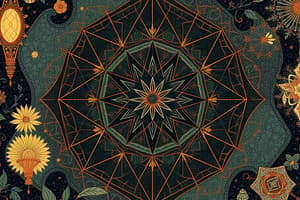Podcast
Questions and Answers
What is the measure of 45 degrees in radians?
What is the measure of 45 degrees in radians?
- $\frac{\pi}{6}$ (correct)
- $\frac{\pi}{2}$
- $\frac{\pi}{3}$
- $\frac{\pi}{4}$
Which tool is commonly used in geometric constructions for drawing circles?
Which tool is commonly used in geometric constructions for drawing circles?
- Ruler
- Calculator
- Compass (correct)
- Protractor
What geometric concept forms the foundation for many mathematical proofs?
What geometric concept forms the foundation for many mathematical proofs?
- Properties of polygons
- Constructions of parallel lines
- Algebraic equations
- Logical reasoning (correct)
Which of the following is an example of a three-dimensional solid?
Which of the following is an example of a three-dimensional solid?
What do students gain insights into by investigating the geometric attributes of different objects?
What do students gain insights into by investigating the geometric attributes of different objects?
Flashcards are hidden until you start studying
Study Notes
Discovering Shapes with Geometry in Mathematics
Geometry is an exciting branch of mathematics where we explore spatial relationships among points, lines, angles, surfaces, and solids. This field has been capturing our curiosity since ancient civilizations first sought to understand and model real-world shapes and patterns. In this exploration, we'll delve into some fundamental concepts of geometry while maintaining a student-friendly approach.
Points and Lines
At the heart of geometry lie points—imaginary, unchanging locations in space. A point does not have size; it occupies zero area and volume. Two distinct points can never occupy the exact same location. We often represent points using capital letters like (A) or (P.)
Lines connect two or more points in a continuous manner. Mathematically speaking, a line consists of all points ((x, y)) whose coordinates satisfy a specific linear equation, such as (y = mx + b,) where (m) denotes slope and (b) represents the y-intercept.
Measuring Angles
Angles help us describe how much one segment turns relative to another when they meet at a common vertex. When measuring angles, we typically use degrees (({}^{\circ})) or radians ((rad)). Degrees range from 0° through 360°, with full rotations being multiples of 360°. Radians span a partial rotation around the unit circle, ranging from 0 to (2\pi) radians, which corresponds to 360°. One degree equals (\frac{\pi}{180} \text{~rad}.)
Geometric Constructions and Proofs
With geometry, there's always opportunity to flex your creativity by constructing shapes using simple tools like circles, rulers, and compasses. For instance, you might draw parallel lines given their distance apart, bisect segments, or even find the center of a circle. These constructions form the foundation for many proofs, allowing us to demonstrate mathematical statements confidently.
Geometrical proofs rely heavily upon logical reasoning, deductive arguments, and sound premises. By examining the properties of figures and applying rules of logic, we arrive at provable conclusions. Many geometers acquire proficiency in sketching diagrams and outlining arguments step-by-step, laying down a solid foundation in critical thinking.
Surfaces and Solids
Beyond exploring flat planes, geometry also encompasses studies involving two-dimensional surfaces and three-dimensional solids. Examples of surfaces could be conical, cylindric, spherical, planar, etc., based on their curvature and shape characteristics. Likewise, various types of solids exist, including cuboids, pyramids, prisms, cylindrical shells, spheres, polyhedra, and so forth.
Investigating these objects helps us gain insights into their geometric attributes like surface areas, volumes, circumferences, and dimensions. As a result, students develop an appreciation for symmetry, duality, transformation, and other abstract concepts that underpin classical and modern geometry alike.
So there you go! With only a handful of fundamental ideas, geometry opens up countless doors to discovery, bringing together artistry and rigor in equal measure. It serves as both a practical toolset and a creative outlet for those seeking to tread uncharted paths in understanding the world around them.
Studying That Suits You
Use AI to generate personalized quizzes and flashcards to suit your learning preferences.




